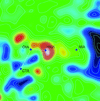issue contents
December 2016 issue

Cover illustration: 6-Amino-5-nitropyridin-2(1H)-one crystallizes from water as a 1:1 complex of its neutral and deprotonated forms, and forms a `skinny' pyrimidine-pyrimidine pair. The pair resembles the known intercalated cytosine pair. Implications of this structure for the use of this heterocycle in artificial DNA are discussed. See Matsuura, Kim, Takahashi, Abboud & Benner [Acta Cryst. (2016), C72, 952-959].
research papers




























 journal menu
journal menu






























